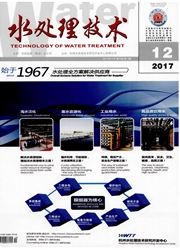

 中文摘要:
中文摘要:
本试验分析了城市二级处理水的残留有机物分子量分布特征及对超滤膜过滤透水性能的影响,并利用混凝法,活性炭吸附,臭氧-活性炭吸附进行了处理。研究结果表明:(1)城市污水厂二级出水中溶解态有机物主要集中在〈2k分子量区间上;(2)混凝处理后,高分子量有机物低分子化效果明显;PAC吸附能有效去除小分子量有机物;臭氧-PAC联用,大分子量有机物和小分子量有机物所占比例均有所下降,表明臭氧氧化与PAC吸附联用在去除有机物方面具有很好的互补性;(3)分子量分布对原水的透水通量影响较大;选择混凝、PAC或臭氧-PAC等作为膜法处理的预处理单元,对城市污水再生处理具有重要价值。
 英文摘要:
英文摘要:
The characteristics of the molecular weight (MW) distribution of residual organic matters in the secondary effluent and the influence of MW distribution on membrane flux were analyzed in this test, and the effect of applicable pretreatment including coagulation, PAC adsorption and ozonation-PAC process on the secondary effluent was investigated. The results showed: (1) The dissolved organic matters in the secondary effluent from municipal wastewater treatment plant were mainly focused on the fraction of lower than MW2000; (2) Coagulation can more effectively remove high-MW organic matters; and PAC adsorption was effective in removing low-MW organic matter; The removal rate of DOC by ozonation-PAC process was much higher than that of PAC alone, which reflects the complementarity between ozonation and PAC adsorption in removing organic matter; (3) membrane flux of low-MW matters was obviously high than the flux of high MW matters.
 同期刊论文项目
同期刊论文项目
 同项目期刊论文
同项目期刊论文
 期刊信息
期刊信息
